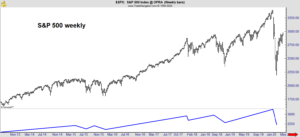Fundamentals matter in the long run. That’s bad news for long-term investors because at current levels, fundamentals tell us stocks are overvalued. This implies low returns over the next five to 10 years.
But is there opportunity for short-term trading?
Recently, my colleague Charles Sizemore highlighted a long-term forecast from GMO, a large asset management firm. The firm and its founder, Jeremy Grantham, have an admirable track record.
GMO correctly called the 1990s dot-com bubble and the 2000s housing bubble. And as Charles observed, “they were also aggressive buyers near the bottoms of both bear markets that followed.”
In their latest long-term forecast, GMO warns investors to expect stock market losses over the next seven years. U.S. large-cap stocks are expected to deliver losses averaging 4.7% per year. Small caps could do better, losing an average of just 3% a year.
This is bad news for investors. GMO’s track record in these forecasts is as admirable as its performance at previous tops.
One study found the correlation between the forecast and future returns was 0.94. A correlation of 1.0 is perfect. Correlations above 0.7 are tradable. So, GMO is good at getting a trend’s direction right.
Based on its forecast, investors should expect poor returns over the next seven years.
Short-Term Trading Opportunities
Another study offers some hope to long-term investors.
On average, GMO underestimates returns of U.S. stocks by about 4% a year. This means large-cap stocks could deliver an average loss of only 1% a year. Small caps might gain an average of 1% a year.
But the best advice is the recommendation Charles made:
We don’t have to dump everything today in anticipation of lousy returns over the next seven years. We can continue to ride this momentum higher and sell later. We can afford to be short-term traders rather than long-term investors.
There will be many opportunities for short-term traders in the next seven years.
The chart below shows the S&P 500 over the past seven years. The blue line at the bottom shows price moves of at least 10%. Moves of this size occurred an average of every eight months. That was in a relatively low-volatility market.
10 Price Moves in S&P 500

There were 10 different opportunities to catch price moves of at least 10%.
In the next seven years, with stock prices likely to fall based on fundamentals, volatility should be high. There will be more opportunities to benefit from short-term moves.
While long-term investors might dread the next few years, short-term traders might have large profits.
P.S. To find out how you can use my “Strike Zone” Indicator to see gains of 364% in 12 days, 323% in 18 days, 496% in 4 days and more, sign up for this FREE broadcast.
Michael Carr is a Chartered Market Technician for Banyan Hill Publishing and the Editor of One Trade, Peak Velocity Trader and Precision Profits. He teaches technical analysis and quantitative technical analysis at New York Institute of Finance. Mr. Carr is also the former editor of the CMT Association newsletter, Technically Speaking.
Follow him on Twitter @MichaelCarrGuru.




